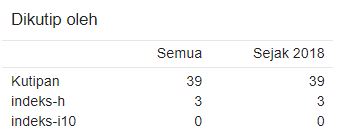Simulasi Sensor Radiasi Matahari dengan Algoritma ANFIS menggunakan MATLAB
Sari
Solar energy has become one of the renewable energy sources that can be converted into electrical energy. Solar cells are used to convert solar energy into electrical energy. Solar radiation is an important factor to consider in the use of solar cells or solar power generation systems. Therefore, it is necessary to develop a solar radiation measurement device. This research is a simulation of a solar cell as a solar radiation sensor using the ANFIS algorithm to calculate the solar radiation value based on the voltage and current from the solar cell. The simulation, conducted using Matlab with solar cell features, a 12-ohm resistor, ANFIS features, and a Fuzzy block, showed good results with an error rate of 0.038 percent. Future research development will involve testing on actual solar cell devices
Kata Kunci
Teks Lengkap:
Tidak berjudulReferensi
Y. Dewantoro, H. Politeknik, and N. Semarang, “Simulasi Solar Cell Dan Solar Module Dengan Matlab Simulink Untuk Pembangkit Listrik Tenaga Surya Numerical Estimation of Photovoltaic-Electrolyzer System Performance on the Basis of a Weather Database View project 3D printing View project Fatahul Arifin Sriwijaya State Polytechnic.” [Online]. Available: https://www.researchgate.net/publication/367241408
K. Dahlan, K. N. Anou, D. Napitupulu, and H. Hamzah, “Simulasi dan Pemodelan Sistem Optimalisasi Daya Panel Surya Menggunakan Metode Pelacakan Titik Daya Maksimum,” SAINTIFIK, vol. 10, no. 1, pp. 6–12, Jan. 2024, doi: 10.31605/saintifik.v10i1.462.
T. Astari Trisnandini, N. Desryanto, and I. Kgs, “SISTEM MONITORING EFEKTIVITAS KINERJA PANEL SURYA DENGAN PENAMBAHAN REFLEKTOR BERBASIS MIKROKONTROLER,” Jetri : Jurnal Ilmiah Teknik Elektro, pp. 1–13, Aug. 2022, doi: 10.25105/jetri.v20i1.13797.
U. Muhammad, S. Mustafa, and S. Sofyan, “Rancang Bangun Sistem Akuisisi Data Solar Power Meter Berbasis Internet of Things (IoT),” Makassar, Sep. 2021. [Online]. Available: https://randomnerdtutorials.com/esp8266-pinout-
T. Pangaribowo, “Implementasi Algoritma Logika Fuzzy Dalam Penentuan Kapasitas Pembangkit Listrik Tenaga Surya Terpusat Off Grid,” 2016.
Y. D. Herlambang, J. D. Armanah, Z. Emazin, A. H. Su’udy, N. F. Aulia, and F. Arifin, “UNJUK KERJA KARAKTERISTIK TEGANGAN ARUS DAN DAYA PADA PANEL SURYA TERHADAP VARIASI RADIASI SURYA MENGGUNAKAN MATLAB SIMULINK,” 2021. [Online]. Available: https://www.researchgate.net/publication/367241475
U. Muhammad, “Rancang Bangun Trainer Pembangkit Listrik Tenaga surya.”
U. Muhammad, S. N. Fitri, and A. A. Rahmansyah, “Rancang Bangun Monitoring Data Pyranometer Berbasis Website,” 2020.
F. A. Widiharsa, “KARAKTERISTIK PANEL SURYA DENGAN VARIASI INTENSITAS RADIASI DAN TEMPERATUR PERMUKAAN PANEL,” TRANSMISI, vol. 4, pp. 233–242, 2006.
F. Midiatmoko, Y. Shalahuddin, and M. Yahya, “PV SOLAR TRACKER BERBASIS MATLAB / SIMULINK UNTUK OPTIMASI DAYA.”
G. Sarjana, J. Teknik, E. Fakultas, A. E. Jayati, and S. M. Eng, “Implementasi Kendali cerdas Adaptive Neural Based Fuzzy Inference System (ANFIS) Pada Sistem MPPT-PV (Photovoltaic).”
S. Syafaruddin, M. Iqbal Abubakar, H. Glorius Soma, S. Mawar Said, and S. Latief, “DETERMINATION OF SENSORLESS INPUT PARAMETERS OF SOLAR PANEL WITH ADAPTIVE NEURO-FUZZY INFERENCE SYSTEM (ANFIS) METHOD,” International Journal of Innovative Computing, vol. 14, no. 6, 2018, doi: 10.24507/ijicic.14.06.xxx.
T. S-, “SISTEM MONITORING DAN KONTROL DAYA PLTS MENGGUNAKAN IOT BERBASIS FUZZY LOGIC.”
F. S. Abdillah, S. Pinardi, and H. Ramza, “Perancangan Sistem Solar Tracker Single-Axis Berbasis ANFIS,” Seminar Nasional TEKNOKA, vol. 9, pp. E50–E58, 2024.
DOI: https://doi.org/10.61141/joule.v5i2.645
Refbacks
- Saat ini tidak ada refbacks.
##submission.copyrightStatement##
INDEXES IN
Jalan Kapasa Raya No. 23 (KIMA)
Makassar-Sulsel 90245
Email: Joule.TLS@politeknikbosowa.ac.id
https://jurnal.politeknikbosowa.ac.id/

This work is licensed under a Creative Commons Attribution 4.0 International License.










